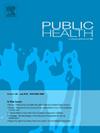Evaluating COVID-19 cases reported across prisons in England from 2020 to 2023: Is enhanced address matching a game-changer for surveillance?
IF 3.9
3区 医学
Q1 PUBLIC, ENVIRONMENTAL & OCCUPATIONAL HEALTH
引用次数: 0
Abstract
Objectives
Gathering real-time surveillance data on infectious diseases in prisons can be challenging, and can contribute to health inequalities, including poorer health outcomes and increased risk of transmission. This study assessed the reliability of the address-matching method developed by the UK Security Health Agency (UKHSA) in detecting COVID-19 cases in prisons across England.
Study design
Retrospective descriptive study.
Methods
The retrospective descriptive study compared data from the UKHSA prison line list generated using the enhanced address-matching enrichment procedure with pseudonymized line list data from the Ministry of Justice (MOJ) in selected English prisons between March 2020 and January 2023. Cases were compared at the regional and prison levels to examine the consistency of positive episode counts over time, and by prison. The study included 104 prisons and excluded young offenders' institutions.
Results
Overall, the comparison showed both MOJ and UKHSA COVID-19 prison episodes were very closely aligned in 2020 and 2021 with generally over ninety percent agreement in most prisons, the close alignment remained consistent overall and at regional levels until January 2022, coinciding with the arrival of the Omicron variant and shortly thereafter the relaxation in testing aligning with the governments living with COVID-19 plan when differences in case counts became more noticeable.
Conclusion
The enhanced address matching method is reliable in identifying COVID-19 prison episodes and could be adapted for active and timely surveillance of other infectious diseases, and in other settings beyond prisons. This can facilitate better and evidence-based policies for planning and intervention during public health outbreaks.

评估2020年至2023年英格兰监狱报告的COVID-19病例:增强地址匹配是否会改变监测的游戏规则?
目标收集监狱传染病的实时监测数据可能具有挑战性,并可能导致健康不平等,包括健康结果变差和传播风险增加。本研究评估了英国安全卫生署(UKHSA)开发的地址匹配方法在英格兰各地监狱检测COVID-19病例的可靠性。研究设计回顾性描述性研究。方法回顾性描述性研究比较了使用增强型地址匹配浓缩程序生成的UKHSA监狱线名单数据与司法部(MOJ)在2020年3月至2023年1月期间选定的英国监狱的假名线名单数据。病例在地区和监狱层面进行比较,以检查阳性事件数随时间和监狱的一致性。这项研究包括104所监狱,不包括青少年罪犯机构。结果总体而言,比较显示司法部和UKHSA在2020年和2021年的COVID-19监狱事件非常接近,大多数监狱的一致性通常超过90%,直到2022年1月,这种紧密的一致性在整体和地区层面保持一致,与Omicron变体的到来相吻合,此后不久,随着病例数差异变得更加明显,与COVID-19计划一致的政府放松了测试。结论增强型地址匹配方法在识别新冠肺炎监狱疫情方面是可靠的,可适用于其他传染病的主动、及时监测,并适用于监狱以外的其他环境。这有助于在公共卫生暴发期间制定更好和基于证据的规划和干预政策。
本文章由计算机程序翻译,如有差异,请以英文原文为准。
求助全文
约1分钟内获得全文
求助全文
来源期刊

Public Health
医学-公共卫生、环境卫生与职业卫生
CiteScore
7.60
自引率
0.00%
发文量
280
审稿时长
37 days
期刊介绍:
Public Health is an international, multidisciplinary peer-reviewed journal. It publishes original papers, reviews and short reports on all aspects of the science, philosophy, and practice of public health.
 求助内容:
求助内容: 应助结果提醒方式:
应助结果提醒方式:


